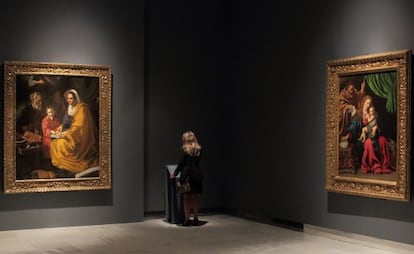Seville shows off restored painting attributed to teenage Velázquez
‘The Education of the Virgin’ sat in storage at Yale University for years before its rediscovery

Few stories have had such an impact on the world of art as the discovery of The Education of the Virgin, a painting once attributed to an unknown Spanish painter but now said to be an early work by 17th-century Spanish master Diego Velázquez.
Painted in Seville around 1617 when the artist was just 17, the painting suffered damage, was partly burned and underwent poor restoration, after which it was kept in storage for years at Yale University.
But in 2010, curator and historian John Marciari published an article in art journal Ars reattributing the work to Velázquez, which led to heated scholarly debate.
Until January 15, visitors to Seville’s Espacio Santa Clara can now gaze upon the impressive restoration work that The Education of the Virgin has undergone since it was rediscovered inside a storage room and subjected to scientific study at Yale University Art Gallery, which owns the painting.
A dissenting opinion
Jonathan Brown, a world expert on Velázquez, does not agree that The Education of the Virgin was painted by the Spanish master. Although he did not attend the Seville symposium because of health reasons, the top American authority on the Spanish painter sent a written statement arguing that the attribution is based on circumstantial evidence.
Brown said stylistic comparisons and technical details are just one way of determining authorship, and are neither more nor less conclusive than visual judgment.
An international group of 29 Velázquez scholars also gathered in Seville last week to discuss the painting, which portrays St Anne teaching the Virgin Mary to read.
Benito Navarrete, curator of the exhibition, has reconstructed the painting’s journey from its discovery to its restoration and public exhibition. Hanging across from it are three other artworks that provide essential clues: The Education of the Virgin by Juan de Roelas (1612), The Holy Family by Luis Tristán (1603) and Velázquez’s own Saint Ildefonso Receiving the Chasuble from the Virgin (circa 1622).
A large gray panel also showcases some of the numerous newspaper headlines that the reattribution provoked.
A text by Marciari recalls the moment it dawned upon him that he was contemplating an early Velázquez inside a storage room. “The first time I saw the painting was in 2003. I immediately thought: this is a great painting, but by whom? It was simply classified as Spanish school. I considered several hypotheses until one day, maybe three or four months later, it suddenly hit me. This is an early Velázquez. I told myself I was crazy, out of my mind. It did not seem possible for Yale to have had a Velázquez for 80 years without anyone noticing it. It couldn’t be ... and right after that, I realized how difficult it would be to prove it.”
He was not wrong about that. For two years, with funding from Spain’s Banco Santander, a team of restorers worked on the painting, which had missing parts and had at one point been “cleaned” with bleach. Fire and water had added to the damage.
X-ray and infrared reflectography techniques have also revealed the way the painter worked on The Education of the Virgin. The repair work uncovered a still life on the left-hand side of the painting and highlighted the quality of the wood of which the table in the picture is made.
The curator says details have emerged that make it impossible to question the fact that this is a work by Velázquez. Although Navarrete is not sure whether or not the painting was a commission, he tends to think it was an experiment by the young painter. “Rather than insist on my thesis, I preferred to organize a scientific show with technical details and information about the painting’s story, its discovery, and its comparison with other works of its era,” he says.
Tu suscripción se está usando en otro dispositivo
¿Quieres añadir otro usuario a tu suscripción?
Si continúas leyendo en este dispositivo, no se podrá leer en el otro.
FlechaTu suscripción se está usando en otro dispositivo y solo puedes acceder a EL PAÍS desde un dispositivo a la vez.
Si quieres compartir tu cuenta, cambia tu suscripción a la modalidad Premium, así podrás añadir otro usuario. Cada uno accederá con su propia cuenta de email, lo que os permitirá personalizar vuestra experiencia en EL PAÍS.
¿Tienes una suscripción de empresa? Accede aquí para contratar más cuentas.
En el caso de no saber quién está usando tu cuenta, te recomendamos cambiar tu contraseña aquí.
Si decides continuar compartiendo tu cuenta, este mensaje se mostrará en tu dispositivo y en el de la otra persona que está usando tu cuenta de forma indefinida, afectando a tu experiencia de lectura. Puedes consultar aquí los términos y condiciones de la suscripción digital.
Últimas noticias
The complicated life of Francesca Albanese: A rising figure in Italy but barred from every bank by Trump’s sanctions
Pinochet’s victims grapple with José Antonio Kast’s rise in Chile
Reinhard Genzel, Nobel laureate in physics: ‘One-minute videos will never give you the truth’
How Japan is trying to avert ‘digital defeat’
Most viewed
- Pablo Escobar’s hippos: A serious environmental problem, 40 years on
- Reinhard Genzel, Nobel laureate in physics: ‘One-minute videos will never give you the truth’
- Why we lost the habit of sleeping in two segments and how that changed our sense of time
- Charles Dubouloz, mountaineering star, retires at 36 with a farewell tour inspired by Walter Bonatti
- The Florida Keys tourist paradise is besieged by immigration agents: ‘We’ve never seen anything like this’








































